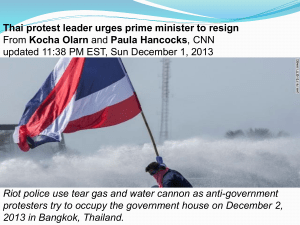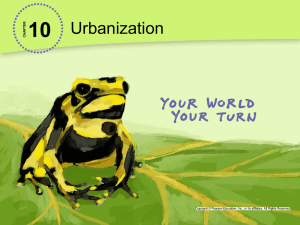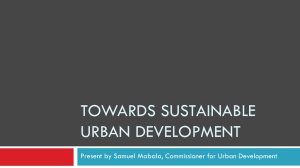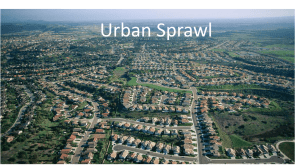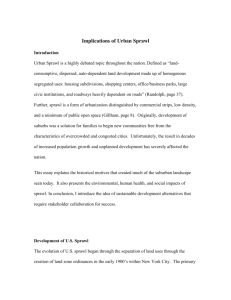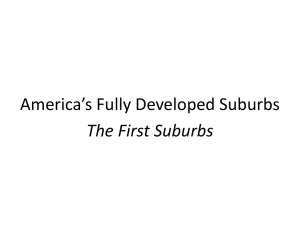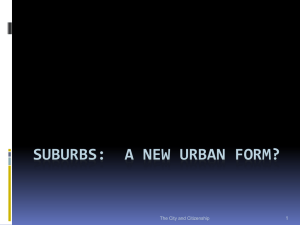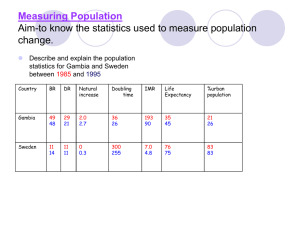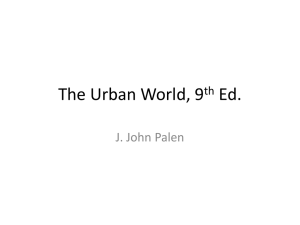Historic City Functions - Glendale Community College
advertisement
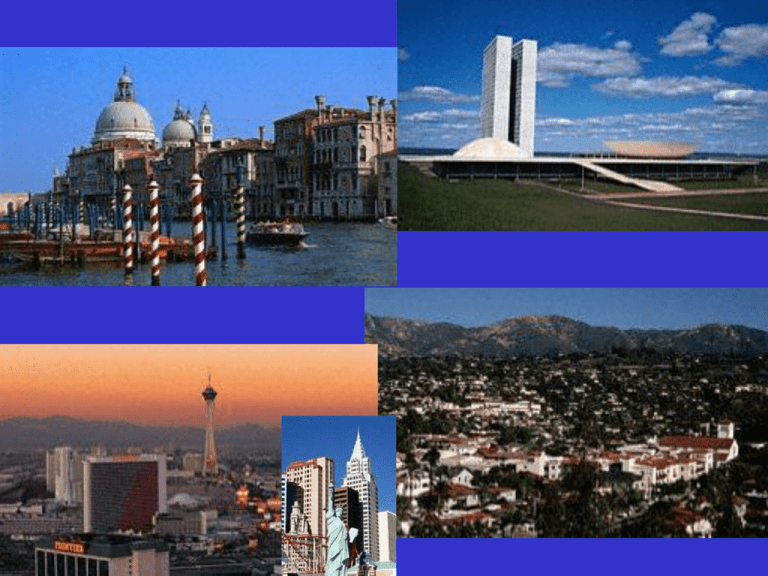
Cities and Urban Geography • Historic Cities and City Functions • Geographic Observations of City Location and Size • The World’s Largest Cities • Suburbanization and Edge Cities • Urban Problems Cities and Urban Geography • In 1950 1/3 of the world lived in a city. • Today 1/2 of us live in cities and the number is increasing. Historic City Functions Commercial Centers - Fresno, Venice, New York Industrial Cities - Manchester, Detroit, Los Angeles Primary Resources - Scotia, Minas Gerais, Nevada City Resort Cities - Santa Barbara, Las Vegas, Marseille Government / Religious Centers - Monterey, D.C., Brasilia Education Centers - Palo Alto, Berkeley Ancient World Cities Oldest cities are found in Mesopotamia, Egypt, China and Indus Valley. Mesopotamia (Jordan/Iraq) Ancient Ur in Iraq Jericho 10,000 B.C. Ur 3,000 B.C. (Iraq) Walled cities based on agricultural trade Ziggurat (stepped temple) Ancient World Cities Oldest cities are found in Mesopotamia, Egypt, China and Indus Valley. E. Mediterranean Athens 2,500 B.C. 1st city to exceed 100,000 Many cities organized into City-States Ancient Athens Medieval World Cities After collapse of Roman Empire in 5th Century, Europe’s cities were diminished or abandoned. European Feudal Cities Begin in 11th Century Independent cities formed in exchange for military service to feudal lord. Improved roads encouraged trade Dense and compact within defensive walls Paris, France Cittadella, Italy Medieval World Cities Cittadella, Italy Cittadella, Italy Location is a key factor in urban growth • Climate, topography, and waterways help determine urban growth. • Many well-located cities are linchpins in trading networks. – Resources from agricultural regions enter cities. – Products are shipped to distant markets. U.S. Urban Growth Stages Industrialization has driven urbanization • Since 1950, urban populations have quadrupled. – Due to a growing human population and increased movement to cities – By 2050, urban populations will grow by 94%. • In developed nations, urbanization has slowed. – Suburbs: the smaller communities that ring cities • Developing nations are urbanizing rapidly. – People are searching for jobs and urban lifestyles. Major Cities of the World Today, for the first time ever, over ½ of the world’s population lives in urban areas. Intraregional Migrations in U.S. For about 100 years the U.S. population has been moving out of the city centers to the suburbs of the cities: suburbanization and counterurbanization Developed Countries: suburbanization automobiles and roads ‘American Dream’ better services lower taxes U.S. intraregional migration during 1990s. Migration by Major Metropolitan Areas in the United States, 199098 (in 1,000s) -1750 -1250 -750 -250 250 750 New York Los Angeles San Francisco Chicago Miami Atlanta Las Vegas Immigration Net domestic migration Phoenix Portland Denver Slide graphic courtesy of Dr. Jean-Paul Rodrigue, Hofstra University 1250 Interregional Migrations U.S. population has been moving Westward and Southward Gold Rush (1849) and Donner Party just the most dramatic examples of hardship. – Wells, Pumps, Aqueducts, Mosquito Control and Air Conditioning have allowed this move which otherwise would be impossible. Loss of Industrial Jobs in east compliments increase in Sunbelt (AZ, FL, CA, etc.) service sector (biotech, communications). The Ten Fastest-Growing Metropolitan Areas, 1990–2000 Source: U.S. Census Bureau, Census 2000; 1990 Census. Web: www.census.gov Metropolitan area Las Vegas, Nev., Ariz. Naples, Fla. Yuma, Ariz. McAllen-Edinburg-Mission, Tex. Austin-San Marcos, Tex. Fayetteville-Springdale-Rogers, Ark. Boise, Idaho Phoenix-Mesa, Ariz. Laredo, Tex. Provo-Orem, Utah Population April 1, 1990 April 1, 2000 852,737 1,563,282 152,099 251,377 106,895 160,026 383,545 569,463 846,227 1,249,763 210,908 311,121 295,851 432,345 2,238,480 3,251,876 133,239 193,117 263,590 368,536 Change, 1990–2000 Number Percent 710,545 83.3% 99,278 65.3 53,131 49.7 185,918 48.5 403,536 47.7 100,213 47.5 136,494 46.1 1,013,396 45.3 59,878 44.9 104,946 39.8 The Ten Fastest-Growing Metropolitan Areas, 2001-2006 Source: U.S. Census Bureau; 2006: Census. Web: www.census.gov The Ten Fastest-Growing Metropolitan Areas, 2008-2009 (plus four previous top ten cities that have slowed their growth) Source: U.S. Census Bureau; 2006: Census. Web: www.census.gov Interregional Migrations in LDCs Populations in the less developed world are rushing to cities in search of work and income. Urbanization migration from rural areas lack of jobs in countryside lack of services in cities Tokyo, Los Angeles, and New York only MDC cities on top 10 list Lagos, Nigeria Mumbai, India Mexico City, Mexico Rank-Size Rule Rank-Size Rule: n thlargest settlement is generally 1/n the population of the largest settlement. In other words, 2nd largest is 1/2 the size of largest. Works best in most developed countries that have full distribution of services. Primate City Rule If the largest settlement in a country has more than twice the number as the second ranking city, it’s called primate. These cities tend to represent the perceived culture of the country and have a disproportionate influence on the country. Largest City Paris London Population 9 million 9 million Second-largest City Population Marseille Birmingham 2 million 2 million Skyscrapers • Why build up? • Why copy Western model? • Where are the world’s tallest buildings? Megalopolis Illustrates the difference between strict city proper definitions and broader urban agglomerations. To define urbanized areas, the U.S. Census Bureau uses the term Metropolitan Statistical Area (MSA) or Consolidated MSA (CMSA) if two of them overlap. Today’s urban centers are unprecedented • Today, 20 cities are home to more than 10 million residents. – Tokyo, Japan has 35 million residents. – New York City has 18.7 million residents. • But the majority of urban dwellers live in smaller cities. Largest World Cities Ten Most Populous in A.D. 1975 1. Tokyo 2. New York 3. Shanghai 4. México 5. São Paulo 6. Osaka 7. Buenos Aires 8. Los Angeles 9. Paris 10. Beijing 19.8 million 15.9 million 11.4 million 11.2 million 9.9 million 9.8 million 9.1 million 8.9 million 8.9 million 8.5 million Source: U.N., 2001 * Note that five of these cities are in the Core or more developed world. Largest World Metropolitan Areas Ten Most Populous Today Rank City 1 Tokyo, Japan Population 28 million 2 New York City, United States 20.1 million 3 Mexico City, Mexico 18.1 million 4 Mumbai, India (Bombay) 18 million 5 Sao Paulo, Brazil 17.7 million 6 Los Angeles, United States 15.8 million 7 Shanghai, China 14.2 million 8 Lagos, Nigeria 13.5 million 9 Kolkata, India (Calcutta) 10 Buenos Aires, Argentina 12.9 million 12.5 million Largest World Cities Ten Most Populous by A.D. 2015 1. Tokyo 28.7 million 2. Bombay 27.4 million 3. Lagos 24.4 million 4. Shanghai 23.4 million 5. Jakarta 21.2 million 6. São Paulo 20.8 million 7. Karachi 20.6 million 8. Beijing 19.4 million 9. Dhaka, Bangladesh 19.0 million 10. México 18.8 million Source: U.N., 2001 * Note that only one of these cities is in the Core of the more developed world! Urbanization in developing countries • Most fast-growing cities are in developing countries. – Less need for farm labor due to industrialization – Wars, conflict, and ecological degradation are driving people to cities. • Many of these cities face overcrowding, pollution, and poverty. – Their economic growth does not match their population growth. Suburbanization: in the wealthiest countries people have moved to suburbs • By the mid-1900s, the U.S. and other countries had accumulated more people than jobs. – Unemployment caused poverty and crime. – Affluent city dwellers moved to cleaner, lesscrowded suburbs. • Suburbs had advantages of space and privacy. – More space, better economic conditions, cheaper real estate, less crime, and better schools • But natural space decreases with increasing suburbs. – People have to drive everywhere, increasing traffic congestion. People in suburbs take up more space On average in the U.S., each suburban resident takes up 11 times as much space than a city dweller. Cities in Crisis, Urban Problems U.S. City Problems Sprawl commutes environmental problems tax flight (bankrupts cities) Racial and Economic Segregation schools taxes democracy School Segregation Sprawl • Houses and roads supplant more than 1 million ha (2.5 million acres) of U.S. land per year. • Sprawl: the spread of low-density urban or suburban development outward from an urban center – Physical spread of development is greater than the rate of population growth. – Phoenix, Arizona’s population grew 12 times larger between 1950 and 2002, while its land area grew 27 times larger. Several types of development lead to sprawl Sprawl has several causes • Human population growth • Rising per capita land consumption: more land per person – People like their space and privacy: “The American Dream?” – Interstate highways make it easier to commute. – Technologies (telecommunications and the Internet) free businesses from dependence on the centralized infrastructure, and workers can live wherever they desire. • Economists, politicians, and city boosters have encouraged it. – “Growth is good” – Increases a community’s economic well-being and political power What is wrong with sprawl? • Transportation: people are forced to drive cars – Pressure to own cars and drive greater distances – Increases dependence on non-renewable petroleum – Increases stress, injuries, deaths. • Pollution from sprawl’s effects on transportation – Carbon dioxide, nitrogen- and sulfurcontaining air pollutants – Motor oil and road salt from roads and parking lots What else is wrong with sprawl? • Health: promotes physical inactivity because driving cars replaces walking – Increases obesity and high blood pressure • Land use: less land is left as forests, fields, farmland, or ranchland – Loss of ecosystem services, recreation, aesthetic beauty, wildlife habitat • Economics: drains tax dollars from communities – Money goes to new communities for roads, water and sewer systems, electricity, police and fire services, schools in new developments Phoenix, Arizona City and regional planning • City (urban) planning: the professional pursuit that attempts to design cities to maximize their efficiency, functionality, and beauty – Planners advise policymakers on development options, transportation needs, public parks, etc. • City planning grew throughout 20th century – Expanding urban populations, inner cities decayed, and wealthier residents fled to suburbs • Regional planning: deals with same issues as city planning, but with broader geographic scales that must coordinate with multiple municipal governments Zoning • Zoning: the practice of classifying areas for different types of development and land use – Homeowners and businesses know what can and cannot be located nearby. • Opponents say that zoning’s government restriction violates individual freedoms. • Proponents say government can set limits for the good of the community. Urban growth boundaries (UGBs) • Limits sprawl: keeps growth in existing urbanized areas – Revitalize downtowns – Protect farms, forests, and their industries – Ensure urban dwellers some access to open space – May reduce infrastructure costs • Disadvantages: – Increases housing prices within their boundaries – Restricts development outside UGB – Increases the density of new housing inside the UGB • Relentless population growth may thwart even the best anti-sprawl efforts. How to Make a Great City Famous Planned Cities Canberra, Australia Brasilia, Brazil Washington, D.C. Irvine, CA Seaside, FL Poundbury, England Smart Growth Pedestrian Friendly Public Transit Increase Density Mix Ethnic and Income Groups Mix Residential, Commericial, and Recreational Uses Urban Planning Building Better Cities What kinds of cultural values are reflected in this landscape? Smart growth • Smart growth: urban growth boundaries and other land use policies to control growth • Proponents promote: – Rejuvenating older existing communities – Building “up, not out” – Focusing development in existing areas – Favoring multistory shop-houses and high-rises New urbanism • New urbanism: neighborhoods are designed on a walkable scale – Homes, businesses, and schools are close together • Functional neighborhoods in which most of a family’s needs can be met without using a car • Zoning rules must cooperate with new urbanism. – Denser development must be allowed. Mass transportation • A key in improvement of quality of urban life – Public buses – Trains and subways – Light rail: smaller rail systems powered by electricity • Cheaper, more energy efficient, and cleaner • Traffic congestion is eased. – Traffic jams cost the U.S. economy $74 billion yearly. – The average American household spends over $8000 a year on automobile-related expenses! Median household income in 2009 was below $50,000. Parks and open spaces are key elements • City dwellers want escape from noise, commotion, and stress. • Natural lands, public parks, and open space provide greenery, scenic beauty, freedom, and recreation. – Protect ecological processes • Parks originated in America at the end of the 19th century. • Even small spaces can make a big difference. – Playgrounds, community gardens, greenways The Geography of Nowhere http://www.ted.com/talks/lang/eng/james_howard_kunstler_dissects_suburbia.html Stewart Brand on Squatter Cities http://www.ted.com/talks/lang/eng/stewart_brand_on_squatter_cities.htm l Intraregional Migrations in LDCs Populations in the less developed world are rushing to cities in search of work and income. Urbanization migration from rural areas lack of jobs in countryside lack of services in cities Tokyo, Los Angeles, and New York only MDC cities on top 10 list Lagos, Nigeria Rank 1 2 3 4 5 6 7 8 9 10 City Tokyo, Japan New York City, United States Mexico City, Mexico Mumbai, India (Bombay) Sao Paulo, Brazil Los Angeles, United States Shanghai, China Lagos, Nigeria Kolkata, India (Calcutta) Buenos Aires, Argentina Mumbai, India Population 28 million 20.1 million 18.1 million 18 million 17.7 million 15.8 million 14.2 million 13.5 million 12.9 million 12.5 million Mexico City, Mexico Changes in Cities in LDCs Populations of cities in the less developed world have been surging: urbanization, migration, natural increase Urbanization in Developing Countries driven by changes in global economy that make farming more challenging the poor live in the suburbs, rich live in CBD cities struggle to provide jobs and housing services overtaxed squatter settlements common crime on the rise Rio De Janeiro, Brazil Europe versus U.S. Cities: Sprawl European cities, including this hypothetical U.K. example, tend to restrict suburban development, thereby concentrating new development in and around existing concentrations. This leaves large rings of open space, so-called greenbelts. What are the social costs of sprawl? Toulouse, France Ferrara, Italy Sogne, Norway Venice, Italy Somewhere in France Amsterdam, The Netherlands Florence, Italy Copenhagen, Denmark European Cities: result of very long histories Complex street patterns - prior to automobile, weird angles Plazas and Squares - from Greek, Roman, Medieval High density and compact form - wall around city or low-growth zoning Low skylines - many built before elevators, others required cathedral or monument to be highest structure Lively downtowns - center of social life, not just office work Neighborhood stability - Europeans moved less frequently than we do. Scars of War - many wars , many cities originally defensive Symbolism - gothic cathedrals, palaces, and castles Municipal Socialism - many residents live in buildings that are owned by city gov’t. Some of these are massive housing projects, others small scale apartment buildings.


